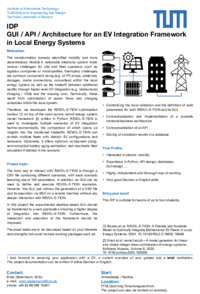IDP - GUI / API / Architecture for an EV Integration Framework in Local Energy Systems
- Institut
- Lehrstuhl für Fahrzeugtechnik
- Typ
- Semesterarbeit
- Inhalt
- theoretisch
- Beschreibung
Motivation:
The transformation towards electrified mobility and more decentralized, flexible & renewable electricity system holds various challenges for site and fleet operators such as logistics companies or municipalities. Exemplary challenges are optimum component sizing (e.g. of PV arrays, stationary storages, mains connections, converters) within the local energy system as well as the tradeoff between additional benfits through higher-level EV integration (e.g. bidirectional charging / V2G) and the ensuing cost. Technically, these result from optimization of power flows and charging schedules within the local system.
Therefore, we developed the REVOL-E-TION optimization toolbox [1] on top of the open source oemof energy system model framework [2] written in Python. REVOL-E-TION is used to investigate multiple scenarios of EV integration techno-economically, the comparison of which opens up insights into the mentioned tradeoffs. REVOL-E-TION can contain multiple fleets with distinct EV configurations and behaviors. Optionally, it offers optimum component sizing, semi-empirical battery aging estimation, and stochastic fleet simulation if defined in the scenario.
Project topic:
The main way to interact with REVOL-E-TION is through a CSV file containing different scenarios, with each scenario featuring about 150 parameters. In addition, an GUI can be used to define and execute REVOL-E-TION scenarios. However, this GUI just mimics the generation of a CSV file and its execution via SSH on a remote machine without any deeper interaction with REVOL-E-TION.
In this project the experimental desktop-based GUI should be transferred to a web application showing a higher degree of integration into REVOL-E-TION. Furthermore, the interaction and execution of the framework should be improved.
The exact tasks are to be discussed based on your interests and strengths but could include working packages such as:
- Centralizing the input validation and the definition of valid parameters for both REVOL-E-TION and its GUI
- Conceptualization and implementation of a scalable frontend/backend architecture
- Conceptualization of an API
- Storing of simulation results in a database
[1] Rosner et al. REVOL-E-TION: A Flexible and Scalable Model to Optimally Integrate Bidirectional EV Fleets in Local Energy Systems. 2024. 10.13140/RG.2.2.19632.16648.
[2] Krien et al. oemof.solph—A model generator for linear and mixed-integer linear optimisation of energy systems, Software Impacts, Volume 6, 2020, 10.1016/j.simpa.2020.100028.
- Voraussetzungen
This IDP is suitable for teams of up to four students.
The following requirements are desirable, but not absolutely necessary:
-
Interested in electric mobility
-
Experience in Python, API design, databases,
GUI design … -
Highly, independent and thorough way of working
-
Very good German or English skills
I look forward to receiving your application with a CV, a current overview of your grades and a brief motivation.
The project documentation can be written in either German or English.In case of questions or the suggestion of alternative topics please contact me: 089 289 10491, brian.dietermanntum.de.
-
- Verwendete Technologien
- Python, Nachhaltigkeit, Elektromobilität, Batterien, Energiesystem, Optimierung
- Tags
- FTM Studienarbeit, FTM Dietermann, FTM Informatik, FTM EV, FTM EV Operations
- Möglicher Beginn
- sofort
- Kontakt
-
Brian Dietermann, M.Sc.
Raum: MW 3511
Tel.: +49 (0) 89 289 10491
brian.dietermanntum.de - Ausschreibung
-
